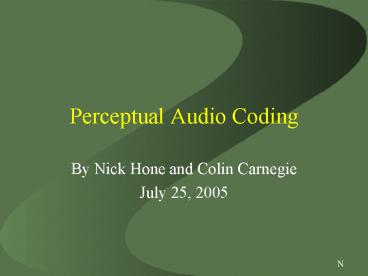Perceptual Audio Coding - PowerPoint PPT Presentation
1 / 21
Title:
Perceptual Audio Coding
Description:
Perceptual Audio Coding. By Nick Hone and Colin Carnegie. July 25, 2005. N. Why Perceptual Coding? The data rate of a standard audio CD is 172 KB/sec ... – PowerPoint PPT presentation
Number of Views:234
Avg rating:3.0/5.0
Title: Perceptual Audio Coding
1
Perceptual Audio Coding
- By Nick Hone and Colin Carnegie
- July 25, 2005
N
2
Why Perceptual Coding?
- The data rate of a standard audio CD is 172
KB/sec - Home Internet connections had speeds of 5 KB/sec
- Perceptual coding exploits the imprecision of the
human ear
N
3
Perceptual Coding Standards
- Audio
- MPEG-1 Part 3 Layers 1, 2, and 3
- Ogg Vorbis
- Video
- MPEG-1 Part 2, MPEG-2 Part 2
- H.264
- Ogg Theora
N
4
Human Auditory Limitations
- Frequency resolution within critical bands
- Loud signals overpower adjacent signals
- Quantization noise is less audible at these
points - we can save bits!
C
5
Compression System
C
6
Filter Bank
- 32 band polyphase filter
- Overlapping bands
- Non Reversible
- Linear (unlike 25 critical bands)
- Noise introduced is negligible
N
7
Psychoacoustic Model
- Operates on 12 samples
- Hann weighted FFT/separated into bands
- Tonal/non tonal power separated
- Non tonal information shifted to geometric mean
- Masking function calculated, using global and
dynamic threshold values
C
8
Bit Allocation
- Quantization required for each subband determined
with iterative process - Starting from total bits, distribute a bit to a
sub-band with the highest signal to mask ratio,
then recalculate ratios
C
9
Polyphase Filter Implementation
- Sub-band filtering achieved using modified
discrete cosine transform - Implemented in MATLAB with loops evaluating the
following equation
- C is the filter response
- X is the PCM samples
- i denotes the current sub-band
N
10
Bitstream Formatting 1
- MPEG-1 Layer 1 frames are independent
- Frames can be randomly accessed
- Each frame stores 384 PCM samples
- Each frame is identified by a valid header
N
11
Bitstream Formatting 2
- Header contains data such as sampling rate,
presence of CRC field - The infrequently used 16 bit CRC field allows
error checking - All sub-bands have a bit allocation field
- Sub-bands with zero bits do not have scale factor
or sample fields
N
12
Analysis Frames
N
13
Implementation-Bit Allocation
- Bit allocation and psychoacoustic models are
combined - Applied to the 32 sub-bands instead of critical
bands
C
14
Implementation-Bit Allocation
- Average power calculated for each sub-band
- Sub-band power scaled by frequency response of
humans ear sensitivity - Sub-bands adjacent to high power sub-bands are
reduced. - Iterative bit allocation process distributes bits
to highest power sub bands
C
15
Power in a Signal
C
16
Bit Allocation
C
17
Test Signal Spectrogram
N
18
Test Signal
- Spectrum spans 0 to 20 kHz
- Most power near 0 Hz
- Noise is relatively low (blue-green)
N
19
Compressed Signal Spectrogram
N
20
Compressed Signal
- Spectrum spans 0 to 4 kHz
- Almost all power concentrated in 0 to 4 kHz
- High frequencies replaced with noise
N
21
Conclusion
- MPEG is really, really hard
- Concepts are simple to prove
- The devil is in the details
C

